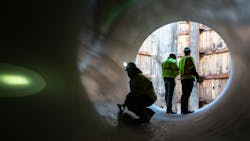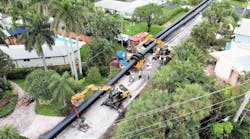With 185 miles of sewer pipe in its coverage area, Great Lakes Water Authority (GLWA) serves approximately 35% of Michigan.
In 2020, GLWA received a WWD Top Project for the CON-149 Emergency Rehab of the Northwest Interceptor, and its winning project for 2022 is The Grand Connection, a sewer connection tunnel. GLWA maintains three main interceptor tunnels, which includes the Detroit River Interceptor (DRI), the North Interceptor – East Arm (NI-EA) and the Northwest Interceptor (NWI).
“The 1,000-foot-long, 9-foot-2-inch crossover tunnel holds promise for future flow management and control between two of the major interceptors in the GLWA collection system; Detroit River Interceptor 15-foot‐6-inch diameter and North Interceptor East Arm 13-foot‐6-inch diameter,” said Mini Panicker, GLWA project manager.
The pipe is glass fiber reinforced polymer mortar pipe and connects the DRI to the NI-EA to divert flow upstream of the connection in the DRI at West Grand Boulevard. With this connection, the downstream DRI section — 16,000 feet of pipe — can be inspected, cleaned and repaired or rehabilitated. The connection also allows for system redundancy, according to the contractor.
“This flow management approach can serve as a model for other combined sewer systems that lack redundancy, have significant flow variations, and have constrained building footprints in metropolitan locations,” said Curtis Rozelle, Jay Dee Contractors project manager.
The two interceptors run parallel but the shortest distance between them — the most ideal location for the connecting tunnel — was too developed and would have created too much complexity to complete. As a result, the team moved the location further downstream where the pipes were around 1,000 feet apart.
Crews in the North Gate Shaft constructed a reinforced concrete gate to prevent backwater from entering the connecting tunnel. For the DRI Gate Shaft, a slide gate structure was used. Finally, the team installed stainless steel gates and rolled angle gate guides in the DRI Gate Shaft to divert upstream DRI flow into the connecting tunnel.
Jay Dee then developed a flow control concept to allow for inspection of pipe that had not been seen by human eyes in nearly a century.
“To overcome existing flow conditions that prevented a complete inspection of the Detroit River Interceptor since it was built 90 years ago, the Jay Dee team conceived and constructed a flow control system that diverted all flow to a nearby interceptor via a new mined tunnel,” Rozelle said.
A field test of The Grand Connection was successfully completed on Feb. 4, 2022.







